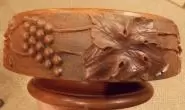A Mystery Mark

As you might recall from some of my previous columns, one of my interests, both historically and as a collector, is Biltmore Estate Industries. It was a true Arts and Crafts cottage industry that in 1901 actually began in a small cottage in Biltmore Village, on the southern outskirts of Asheville. In that tiny cottage, professionally trained woodcarver Eleanor Park Vance began showing a half dozen local boys how to carve dogwood blossoms, grape vines, and oak leaves around walnut bowls, picture frames, trays, and bookends.
By 1905, with financial assistance from George Vanderbilt and encouragement from his wife Edith, the small club officially became known as Biltmore Estate Industries. Led by Eleanor Vance, who designed all of their early motifs, and her partner Charlotte Yale, Biltmore Estate Industries provided scores of young men and women with the opportunity to learn woodworking, woodcarving, weaving, and embroidery. Sales from their small showroom in Biltmore Village were brisk, as both a growing number of tourists and local townspeople sought their exquisitely carved work to display in their homes.
Although I had never heard of Biltmore Estate Industries before moving to Asheville in 1989, I too was smitten by their deeply carved bowls and bookends that showed up regularly in area antiques shops and auction houses. Helping in my personal quest, from 1905 until 1917 the pieces were clearly branded with their shopmark: the word “Forward” inside an arrow banner placed over the words “Biltmore, N.C.” In 1917, after the business was sold and moved next to the famed Grove Park Inn, the name was shortened and “Asheville. N.C.” began appearing beneath the banner.
But, as it turned out, this was not the only mark to be found on their work.

Two weeks ago, Brunk Auctions offered one of their nine-inch walnut bowls encircled by deeply carved grape leaves. The pedestal bowl featured some of the finest carving I had ever seen, which in itself would have been reason enough for me to bid on it, but in addition to the familiar branded mark on the bottom, this one bore a mystery mark (pictured).
I had seen this same incised (not branded) mark on just four other pieces, all of which displayed the same high level of deep, exquisite, flawless carving. This was no student work. This was professional, quality work that required years of training to execute, years that I don’t think any of the young carvers at Biltmore Estate Industries could have amassed so early in the firm’s history.
But the mystery mark, while including the letter “E,” did not contain the initials “P” or “V” that would have linked it to Eleanor Park Vance. In fact, as you can see, the right half of the circular mark does not contain any readily identifiable initials. And a close study of the names of known woodcarvers who worked at Biltmore Estate Industries in those early years did not provide a match to the incised lines.
Never having been shy about forming an opinion and voicing it, I am presently convinced that the carving on these pieces was done by Eleanor Vance, but that she included an initial(s) of the other(s) who played a role in its creation, such as first turning the bowl on the lathe or cutting the fireplace bellows out on the bandsaw or perhaps lending a hand in the background carving.
What also makes me think that Eleanor Vance had a hand in these pieces is the location of the mystery mark. Rather than appearing on the underside, next to the branded mark, it is cut into the outside of the bowls. Had the mystery mark not been cut by the carver, anyone else would have risked serious reprimand for so boldly signing the piece in a way that could have been considered detrimental to the design of the carving.
Nevertheless, this remains only a theory, but one which I am determined to somehow prove – or disprove.

Until next Monday,
A mystery mark is still better than no mark at all.
Bruce
